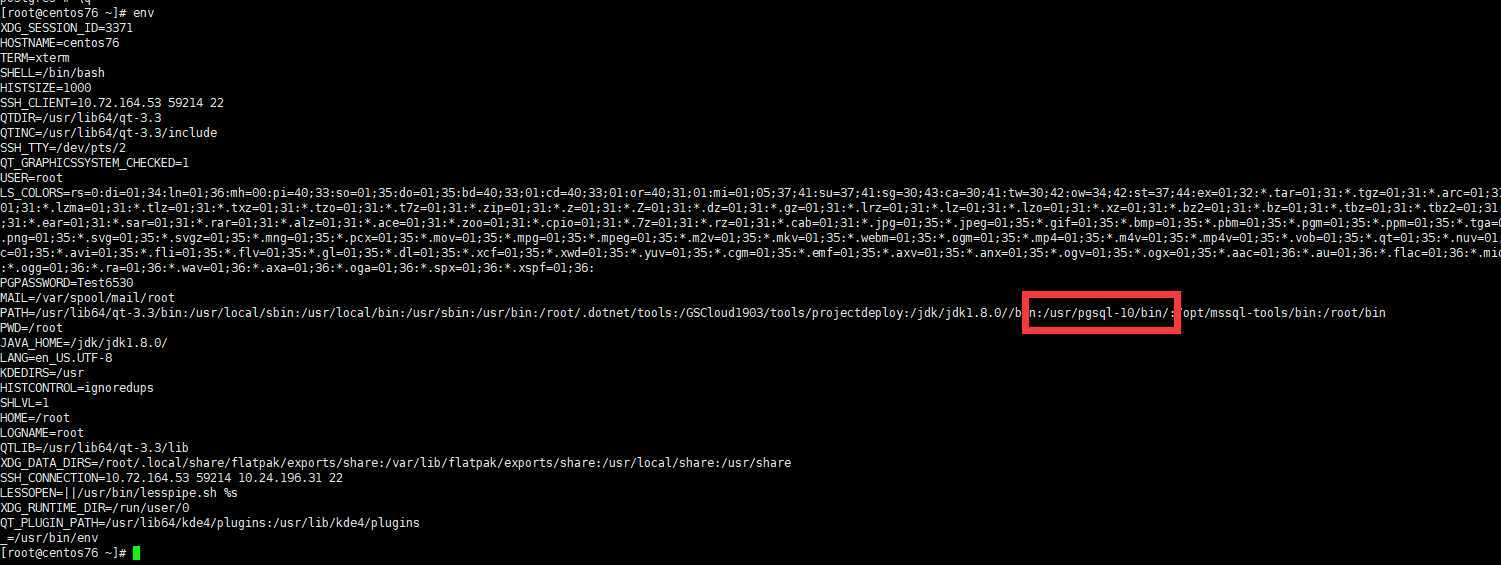标签:变量 info lan copy extern tput int pattern class
1. 登录PG数据库.
psql -U postgres
界面效果为:
[root@centos76 ~]# psql -U postgres psql (10.7) Type "help" for help. postgres=#
其实这里面有一个主意事项. psql 的 命令执行 其实是在环境变量里面的
我这边使用的是rpm 方式安装的pg 数据库.

2. 简单说一下pgsql 的相关命令
使用反斜线作为命令前缀.
退出 \q
列出所有的数据库 \l
更改当前连接的数据库 \c
详细的帮助信息为:
postgres=# \? General \copyright show PostgreSQL usage and distribution terms \crosstabview [COLUMNS] execute query and display results in crosstab \errverbose show most recent error message at maximum verbosity \g [FILE] or ; execute query (and send results to file or |pipe) \gexec execute query, then execute each value in its result \gset [PREFIX] execute query and store results in psql variables \gx [FILE] as \g, but forces expanded output mode \q quit psql \watch [SEC] execute query every SEC seconds Help \? [commands] show help on backslash commands \? options show help on psql command-line options \? variables show help on special variables \h [NAME] help on syntax of SQL commands, * for all commands Query Buffer \e [FILE] [LINE] edit the query buffer (or file) with external editor \ef [FUNCNAME [LINE]] edit function definition with external editor \ev [VIEWNAME [LINE]] edit view definition with external editor \p show the contents of the query buffer \r reset (clear) the query buffer \s [FILE] display history or save it to file \w FILE write query buffer to file Input/Output \copy ... perform SQL COPY with data stream to the client host \echo [STRING] write string to standard output \i FILE execute commands from file \ir FILE as \i, but relative to location of current script \o [FILE] send all query results to file or |pipe \qecho [STRING] write string to query output stream (see \o) Conditional \if EXPR begin conditional block \elif EXPR alternative within current conditional block \else final alternative within current conditional block \endif end conditional block Informational (options: S = show system objects, + = additional detail) \d[S+] list tables, views, and sequences \d[S+] NAME describe table, view, sequence, or index \da[S] [PATTERN] list aggregates \dA[+] [PATTERN] list access methods \db[+] [PATTERN] list tablespaces \dc[S+] [PATTERN] list conversions \dC[+] [PATTERN] list casts \dd[S] [PATTERN] show object descriptions not displayed elsewhere \dD[S+] [PATTERN] list domains \ddp [PATTERN] list default privileges \dE[S+] [PATTERN] list foreign tables \det[+] [PATTERN] list foreign tables \des[+] [PATTERN] list foreign servers \deu[+] [PATTERN] list user mappings \dew[+] [PATTERN] list foreign-data wrappers \df[antw][S+] [PATRN] list [only agg/normal/trigger/window] functions \dF[+] [PATTERN] list text search configurations \dFd[+] [PATTERN] list text search dictionaries \dFp[+] [PATTERN] list text search parsers \dFt[+] [PATTERN] list text search templates \dg[S+] [PATTERN] list roles \di[S+] [PATTERN] list indexes \dl list large objects, same as \lo_list \dL[S+] [PATTERN] list procedural languages \dm[S+] [PATTERN] list materialized views \dn[S+] [PATTERN] list schemas \do[S] [PATTERN] list operators \dO[S+] [PATTERN] list collations \dp [PATTERN] list table, view, and sequence access privileges \drds [PATRN1 [PATRN2]] list per-database role settings \dRp[+] [PATTERN] list replication publications \dRs[+] [PATTERN] list replication subscriptions \ds[S+] [PATTERN] list sequences \dt[S+] [PATTERN] list tables \dT[S+] [PATTERN] list data types \du[S+] [PATTERN] list roles \dv[S+] [PATTERN] list views \dx[+] [PATTERN] list extensions \dy [PATTERN] list event triggers \l[+] [PATTERN] list databases \sf[+] FUNCNAME show a function‘s definition \sv[+] VIEWNAME show a view‘s definition \z [PATTERN] same as \dp Formatting \a toggle between unaligned and aligned output mode \C [STRING] set table title, or unset if none \f [STRING] show or set field separator for unaligned query output \H toggle HTML output mode (currently off) \pset [NAME [VALUE]] set table output option (NAME := {border|columns|expanded|fieldsep|fieldsep_zero| footer|format|linestyle|null|numericlocale|pager| pager_min_lines|recordsep|recordsep_zero|tableattr|title| tuples_only|unicode_border_linestyle| unicode_column_linestyle|unicode_header_linestyle}) \t [on|off] show only rows (currently off) \T [STRING] set HTML <table> tag attributes, or unset if none \x [on|off|auto] toggle expanded output (currently off) Connection \c[onnect] {[DBNAME|- USER|- HOST|- PORT|-] | conninfo} connect to new database (currently "postgres") \conninfo display information about current connection \encoding [ENCODING] show or set client encoding \password [USERNAME] securely change the password for a user Operating System \cd [DIR] change the current working directory \setenv NAME [VALUE] set or unset environment variable \timing [on|off] toggle timing of commands (currently off) \! [COMMAND] execute command in shell or start interactive shell Variables \prompt [TEXT] NAME prompt user to set internal variable \set [NAME [VALUE]] set internal variable, or list all if no parameters \unset NAME unset (delete) internal variable Large Objects \lo_export LOBOID FILE \lo_import FILE [COMMENT] \lo_list \lo_unlink LOBOID large object operations
3. 具体命令就是
展示所有数据库
\l
效果为:
gscloud=# \l
List of databases
Name | Owner | Encoding | Collate | Ctype | Access privileges
---------------+---------------+----------+-------------+-------------+---------------------------------
GSCloud1903 | GSCloud1903 | UTF8 | en_US.UTF-8 | en_US.UTF-8 | =Tc/GSCloud1903 +
| | | | | GSCloud1903=CTc/GSCloud1903
展示所有用户
\dg
gscloud=# \dg
List of roles
Role name | Attributes | Member of
---------------+------------------------------------------------------------+-----------
GSCloud1903 | Superuser, Replication | {}
创建用户
create role zhaobsh;
设置密码
alter role zhaobsh with password ‘Test6530‘;
or
\password zhaobsh
修改属主
alter database "GSCloud1903" owner to zhaobsh;
增加权限
grant all on database "GSCloud1903" to zhaobsh;
设置是 supseruser 以及 登录权限
alter user zhaobsh superuser login
标签:变量 info lan copy extern tput int pattern class
原文地址:https://www.cnblogs.com/jinanxiaolaohu/p/11452472.html